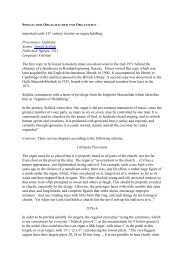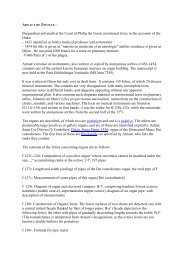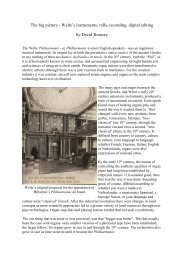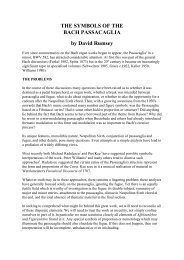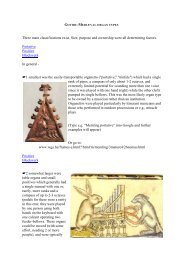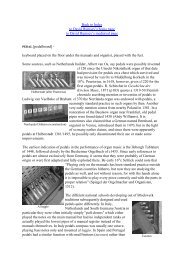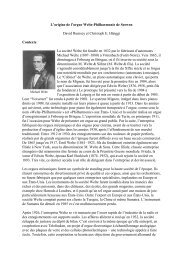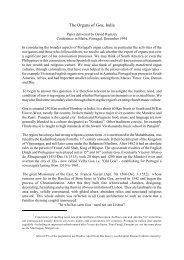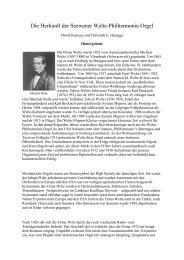Bach and the Holy Trinity - David Rumsey
Bach and the Holy Trinity - David Rumsey
Bach and the Holy Trinity - David Rumsey
You also want an ePaper? Increase the reach of your titles
YUMPU automatically turns print PDFs into web optimized ePapers that Google loves.
musical textures, expression <strong>and</strong> structures.<br />
6<br />
The use of paragrams <strong>and</strong> gematria in <strong>Bach</strong>’s literary, rhetorical <strong>and</strong> ma<strong>the</strong>matical culture<br />
was shown to exist in his music. The variety of available number-alphabets - Latin<br />
milesian, Latin natural order, Pyramidal, dodecangular, octangular, cubica <strong>and</strong> so on - was<br />
investigated <strong>and</strong> proof offered that Ruth Tatlow’s Latin Natural Order variant one was<br />
<strong>the</strong> only such alphabet <strong>Bach</strong> could have used. This coincidentally also proved statistically<br />
beyond all reasonable doubt (to better than 1 in 5 trillion trillion trillion) that <strong>Bach</strong> was<br />
active in this area. To those who were <strong>the</strong>re I trust that I need offer no fur<strong>the</strong>r justification<br />
for what I am about to say. For those who were not I beg of you, if necessary, to take a<br />
temporary leap-of-faith in accepting some of <strong>the</strong> material which now follows. Viewed<br />
from a twentieth century perspective it may seem far-fetched, but from a mid-eighteenth<br />
century perspective it was a quite normal practice in religious, literary <strong>and</strong> musical fields.<br />
th<br />
In <strong>the</strong> course of that paper I discussed certain elements of this 18 century German<br />
musical language:<br />
1) Affektenlehre - known in English as “Doctrine of <strong>the</strong> Affections”:<br />
was <strong>the</strong> belief held in <strong>the</strong> 17th <strong>and</strong> early 18th Centuries, that <strong>the</strong> principal<br />
aim of music is to arouse <strong>the</strong> passions or affections (love, hate, joy, anger,<br />
1<br />
fear, etc., conceived as rationalised, discrete <strong>and</strong> relatively static states) .<br />
th<br />
2) Figurenlehre, a fully documented 18 century practice of music defined as<br />
“Any of various attempts made in <strong>the</strong> 17th <strong>and</strong> 18th Centuries to codify<br />
music according to classes of musical figures thought to be analogous to<br />
2<br />
<strong>the</strong> figures of rhetoric” .<br />
And fur<strong>the</strong>rmore:<br />
1<br />
2<br />
3<br />
“. . . <strong>the</strong> whole of <strong>the</strong> Baroque Affektenlehre was predicated on<br />
[hermeneutics], <strong>and</strong> all composers of <strong>the</strong> age attempted to portray words,<br />
even ideas, by using musical figures that have a pictorial quality expressible<br />
in <strong>the</strong> very graphic image of <strong>the</strong> score. . .” 3<br />
ed. Don R<strong>and</strong>el, The New Harvard Dictionary of Music, Belknap Harvard<br />
ed. Don R<strong>and</strong>el, The New Harvard Dictionary of Music, Belknap Harvard<br />
Paul Henry Lang George Frideric H<strong>and</strong>el (Faber & Faber) especially pp.624ff.



